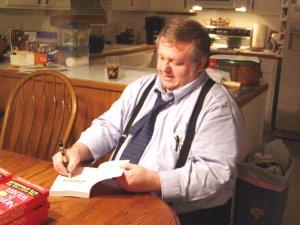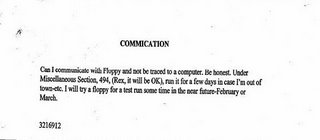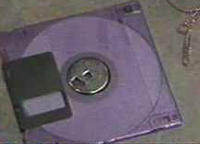BTK is Back
 A Wichita lawyer named Robert Beattie was concerned that the BTK case was being all but forgotten. He set out to write a book about the investigation that tried so hard to capture this elusive killer, who he still reasoned to be a potential threat to the public even though the last known murder had occurred in 1977. BTK was attributed with seven murders and the attempt on Anna Williams in 1979. Beattie was responsible for renewed interest in the BTK case as early as 2003, and the message board Crime and Justice began discussing the case again on the Internet. January 2004 was the 30th anniversary of the Otero murders, and the Wichita Eagle ran an article about the crime and the BTK killer. In conjuction with that came the announcement of the publication of Robert Beattie's new book. These events more than captured Dennis Rader's attention. He became alarmed that someone else would be telling what was his own story, and suddenly his plans for an eventual reemergence were greatly accelerated.
A Wichita lawyer named Robert Beattie was concerned that the BTK case was being all but forgotten. He set out to write a book about the investigation that tried so hard to capture this elusive killer, who he still reasoned to be a potential threat to the public even though the last known murder had occurred in 1977. BTK was attributed with seven murders and the attempt on Anna Williams in 1979. Beattie was responsible for renewed interest in the BTK case as early as 2003, and the message board Crime and Justice began discussing the case again on the Internet. January 2004 was the 30th anniversary of the Otero murders, and the Wichita Eagle ran an article about the crime and the BTK killer. In conjuction with that came the announcement of the publication of Robert Beattie's new book. These events more than captured Dennis Rader's attention. He became alarmed that someone else would be telling what was his own story, and suddenly his plans for an eventual reemergence were greatly accelerated. Rader fumed over what to do for the next couple months but then took action. On March 17 he mailed an envelope to the Wichita Eagle from a Bill Thomas Killman. It contained three photocopied pictures of his own photos of the dying Vicki Wegerle taken in 1986, as well as a photocopy of her missing driver's license. He signed it with the BTK symbol he had used in his previous letters in the 1970s. The letter was forwarded to the FBI who confirmed its authenticity as a BTK communication. An old cold case was solved, but the uproar had only just begun.
Rader fumed over what to do for the next couple months but then took action. On March 17 he mailed an envelope to the Wichita Eagle from a Bill Thomas Killman. It contained three photocopied pictures of his own photos of the dying Vicki Wegerle taken in 1986, as well as a photocopy of her missing driver's license. He signed it with the BTK symbol he had used in his previous letters in the 1970s. The letter was forwarded to the FBI who confirmed its authenticity as a BTK communication. An old cold case was solved, but the uproar had only just begun.As soon as the story hit the media, BTK was suddenly back in the spotlight like never before, this time with the added dimension of the Internet. Discussion boards, chatrooms and websites sprouted up dedicated to the unsolved mystery of the BTK case. It consumed the media in Wichita and beyond. Some of the same fear and paranoia that had existed in the 1970s soon became evident.
 The dust hadn't begun to settle when Rader sent a second letter, this time on May 5, 2004 to the studios of KAKE-TV, the Wichita ABC affililiate. This was a lengthy word puzzle consisting of columns of letters and a few numbers mixed in. The FBI verified that this also came from BTK, as he characteristically used his unique signature, but couldn't make any particular sense out of the puzzle.
The dust hadn't begun to settle when Rader sent a second letter, this time on May 5, 2004 to the studios of KAKE-TV, the Wichita ABC affililiate. This was a lengthy word puzzle consisting of columns of letters and a few numbers mixed in. The FBI verified that this also came from BTK, as he characteristically used his unique signature, but couldn't make any particular sense out of the puzzle.On June 9, 2004 Rader left a package taped to a stop sign at the corner of First and Kansas, in the middle of the city. This contained a disturbing collection of documents, including a letter detailing the grisly murders of the Otero family and a sketch of a nude and bound female hanging by a rope. Eleven year old Josephine Otero had been hanged by a rope in the basement of their home in 1974. The sketch was labeled, "The Sexual Thrill is My Bill." Also enclosed was a chapter list entitled "The BTK Story" that mimicked the chapter list of David Lohr's original article on BTK at the on-line Crime Library. Chapter One was entitled, "A Serial Killer is Born."
On July 17, 2004 a package marked "BTK" was found in a book return at the Wichita Public Library downtown. It contained a worrisome message: "I have spotted a female that I think lives alone and/or is a spotted latchkey kid. Just got to work out the details. I'm much older (not feeble) now and have to conditions myself carefully. Also my thinking process is not as sharp as it uses to be ... I think fall or winter would be just about right for the HIT. Got to do it this year or next! ... time is running out for me." This same package contained an intriguing claim that he, BTK, had engineered the recent death of a 19 year old man from Argonia, Kansas, named Jake Allen. Jake Allen had committed suicide by lying on railroad tracks 12 days earlier. BTK claimed to have lured the young man to his death via a series of computer chats. (This claim was later disproven as a hoax, as there was no evidence that Allen had ever had any such Internet chat with anyone, and his death is still seen as a suicide).
Despite huge pressure from the public, the police refused to release many details of the packages from June on, as it was feared that hearing these things could provoke BTK into a killing frenzy.
The fifth drop didn't occur until October 22, 2004 when a UPS worker found a strange manila envelope while picking up the contents of the UPS box at the Omni Center by Second and Kansas in Wichita. This consisted of a very disturbing assortment of cards that had images pasted on them. There was a collage of pictures of children with bindings drawn across their bodies and faces. This envelope also contained what BTK claimed to be his autobiography, listing a number of details about his life such as being born in 1939, his father dying in the war, mother dated a railroad detective and so on. BTK claimed to be fascinated with railroads and usually lived near railroad tracks. Almost all of it was false information, an attempt to mislead police into researching false clues. The police did release the autobiography to the public a few weeks later, which undoubtedly would have greatly pleased if not excited Dennis Rader.
 What the Wichita Police Dept. was actually doing was following the FBI's advice: keep the killer communicating. Using lead detective Lt. Ken Landwehr as the sole media spokesperson, the strategy was to establish a sort of familiarity between the criminal and the media person, so that BTK would begin to feel as though Landwehr was talking to him directly in a personal sort of way. The idea was to not offend him nor to over-excite him into killing some more. Just keep communicating until he makes a mistake. It was a plan that led directly to the solving of the case.
What the Wichita Police Dept. was actually doing was following the FBI's advice: keep the killer communicating. Using lead detective Lt. Ken Landwehr as the sole media spokesperson, the strategy was to establish a sort of familiarity between the criminal and the media person, so that BTK would begin to feel as though Landwehr was talking to him directly in a personal sort of way. The idea was to not offend him nor to over-excite him into killing some more. Just keep communicating until he makes a mistake. It was a plan that led directly to the solving of the case.On December 1, 2004 officers of the Wichita Police Dept. stormed the house of Roger Valadez, who lived in a house in Wichita with peeling paint within sight of railroad tracks. He was held on a minor outstanding warrant, but apparently was suspected of being the BTK killer. A DNA test quickly exonerated him however. Ultimately police would take some 1,300 DNA swabs of men searching for a match to BTK's semen left at crime scenes.
 Rader's sixth drop was found on December 14, 2004. A man walking through Murdock Park that night noticed a package wrapped in white plastic leaning against a tree. Out of curiosity he took it home with him and opened it. It contained a "PJ" doll. The doll's head had a plastic bag tied over it. Its hands were tied behind its back and its feet were bound together. Tied to the feet was a real driver's license belonging to BTK murder victim Nancy Fox whom he had killed in December 1977. The family notified KAKE-TV, who arrived and photographed the contents and notified police. KAKE agreed not to broadcast what was found in the package, for fear of arousing the killer.
Rader's sixth drop was found on December 14, 2004. A man walking through Murdock Park that night noticed a package wrapped in white plastic leaning against a tree. Out of curiosity he took it home with him and opened it. It contained a "PJ" doll. The doll's head had a plastic bag tied over it. Its hands were tied behind its back and its feet were bound together. Tied to the feet was a real driver's license belonging to BTK murder victim Nancy Fox whom he had killed in December 1977. The family notified KAKE-TV, who arrived and photographed the contents and notified police. KAKE agreed not to broadcast what was found in the package, for fear of arousing the killer.On January 1, 2005 Dennis Rader officially became the new president of the church council at Christ Lutheran Church in Wichita.
Eight days into the new year Rader left a Special K cereal box
 marked "BTK" and "bomb" in the bed of a pickup truck parked at the Home Depot on North Woodlawn. The truck belonged to an employee of Home Depot. He thought it was trash at first and put it in a trash can at home. Luckily he forgot to put that trash can out for collection. On January 25th when police arrived at the Home Depot looking for clues in the BTK case having been tipped off by a postcard from BTK, the man realized the significance of the box and was still able to retrieve it. By reviewing surveillance tape of the parking lot for January 8 the police had their first glimpse of BTK, but the image was too far away and blurry for identification. But by measuring the wheelbase of the black vehicle he was driving it was determined the vehicle was a Jeep Cherokee. Despite having installed alarm systems for a living, Rader was apparently unaware that surveillance cameras had become a commonplace item.
marked "BTK" and "bomb" in the bed of a pickup truck parked at the Home Depot on North Woodlawn. The truck belonged to an employee of Home Depot. He thought it was trash at first and put it in a trash can at home. Luckily he forgot to put that trash can out for collection. On January 25th when police arrived at the Home Depot looking for clues in the BTK case having been tipped off by a postcard from BTK, the man realized the significance of the box and was still able to retrieve it. By reviewing surveillance tape of the parking lot for January 8 the police had their first glimpse of BTK, but the image was too far away and blurry for identification. But by measuring the wheelbase of the black vehicle he was driving it was determined the vehicle was a Jeep Cherokee. Despite having installed alarm systems for a living, Rader was apparently unaware that surveillance cameras had become a commonplace item. The box itself contained information about some of his "PJs" or projects, intended victims that he had watched or stalked. It also contained more misleading information of how he lived in a 3 story home in Wichita with an elevator that had a bomb in the basement rigged to explode if the house were invaded. Rader also asked a peculiar question to the detectives:
 if he put his writings on a computer disk, would it be traceable? He requested a response to be posted in the Wichita Eagle classified ads in the Miscellaneous category using his code name, Rex.
if he put his writings on a computer disk, would it be traceable? He requested a response to be posted in the Wichita Eagle classified ads in the Miscellaneous category using his code name, Rex.The eighth drop
 was another cereal box from the "cereal" killer, this one a Post Toasties. It was discovered on January 25, 2005 as the result of a tip from drop #9, which was a postcard sent to KAKE-TV with a return address of "S. Killet" plus the address of the Otero house. Drop #9 stated the location of the Post Toasties box and mentioned the drop at Home Depot back on January 8, which triggered the investigation there that ultimately located the Special K box.
was another cereal box from the "cereal" killer, this one a Post Toasties. It was discovered on January 25, 2005 as the result of a tip from drop #9, which was a postcard sent to KAKE-TV with a return address of "S. Killet" plus the address of the Otero house. Drop #9 stated the location of the Post Toasties box and mentioned the drop at Home Depot back on January 8, which triggered the investigation there that ultimately located the Special K box.The Post Toasties box was found leaning against a road sign on a desolate unpaved section of North Seneca to the north of the Wichita city limits. KAKE videotaped the box without touching it and notified police. It had a brick on top of it and appeared weathered.
 It was later revealed to have contained another doll, this one with a rope tied around its neck and tied to a plumbing fixture, simulating the hanging of Josephine Otero.
It was later revealed to have contained another doll, this one with a rope tied around its neck and tied to a plumbing fixture, simulating the hanging of Josephine Otero.The tenth drop was another postcard that arrived on February 3,
 again sent to KAKE. Return address was Happ Kakemann, a 1950s character from KAKE's past. Rader wrote: Thank you for your quick response on #7 and 8. Thank to the news team for their efforts. Sorry about Susan's and Jeff's colds. Business issues: Tell WPD that I receive Newspaper Tip for a go. Test run soon. Thanks. PS: May want to use KTV-PC-etc code # and Letters from me for my Verification code to you. He was referring to the newspaper ad in the Wichita Eagle placed there by detectives to answer his question about the safety of sending in a computer disk. The responding ad had assured him in agreed-upon code: Rex it will be OK.
again sent to KAKE. Return address was Happ Kakemann, a 1950s character from KAKE's past. Rader wrote: Thank you for your quick response on #7 and 8. Thank to the news team for their efforts. Sorry about Susan's and Jeff's colds. Business issues: Tell WPD that I receive Newspaper Tip for a go. Test run soon. Thanks. PS: May want to use KTV-PC-etc code # and Letters from me for my Verification code to you. He was referring to the newspaper ad in the Wichita Eagle placed there by detectives to answer his question about the safety of sending in a computer disk. The responding ad had assured him in agreed-upon code: Rex it will be OK. Drop #11 arrived at the studios of KSAS-TV on February 16, the Fox affiliate in Wichita. It contained a letter, a piece of jewelry and a purple diskette referred to as "Test Floppy for WPD review." Detectives wasted little time analyzing the diskette and found software on it from Christ Lutheran Church in Wichita and the name Dennis. Rader had apparently thought he had erased the original contents of the diskette and that it would be "safe" to use it for his purposes. A quick Internet search brought up a website for the church mentioning its current president, Dennis Rader. A group of detectives quietly drove by Rader's house in Park City and noted a black Jeep Cherokee parked in the driveway. Rader was placed under surveillance while a subpoena was secretly obtained for a DNA sample of his daughter from medical records. The familial DNA was a match to DNA found from semen at BTK crime scenes and the case was solved. (Contrary to early media reports, Kerri Rader never suspected her father was BTK nor did she turn him in. She was asked to submit a DNA sample directly at her home in Michigan within an hour after the arrest, but never knew until later that her DNA had been used to solve the BTK case.)
Drop #11 arrived at the studios of KSAS-TV on February 16, the Fox affiliate in Wichita. It contained a letter, a piece of jewelry and a purple diskette referred to as "Test Floppy for WPD review." Detectives wasted little time analyzing the diskette and found software on it from Christ Lutheran Church in Wichita and the name Dennis. Rader had apparently thought he had erased the original contents of the diskette and that it would be "safe" to use it for his purposes. A quick Internet search brought up a website for the church mentioning its current president, Dennis Rader. A group of detectives quietly drove by Rader's house in Park City and noted a black Jeep Cherokee parked in the driveway. Rader was placed under surveillance while a subpoena was secretly obtained for a DNA sample of his daughter from medical records. The familial DNA was a match to DNA found from semen at BTK crime scenes and the case was solved. (Contrary to early media reports, Kerri Rader never suspected her father was BTK nor did she turn him in. She was asked to submit a DNA sample directly at her home in Michigan within an hour after the arrest, but never knew until later that her DNA had been used to solve the BTK case.)After leaving the office to eat lunch at home as was his custom, on February 25, 2005 Rader was driving home when he noticed he was totally surrounded by police, a huge number of them. He surrendered quietly and was led to a waiting police car, handcuffed.
"Hello, Mr. Landwehr," he said once inside the car.
"Hello, Mr. Rader," Lt. Ken Landwehr responded.
Next: County Jail
<< Back to Chapter 1